1st PUC Physics Question and Answer: Units and Measurements
Looking for 1st PUC Physics textbook answers? You can download Chapter 2: Units and Measurements Questions and Answers PDF, Notes, and Summary here. 1st PUC Physics solutions follow the Karnataka State Board Syllabus, making it easier for students to revise and score higher in exams.
Karnataka 1st PUC Physics Textbook Answers—Reflections Chapter 2
Units and Measurements Questions and Answers, Notes, and Summary
1st PUC Physics Chapter 2
Units and Measurements
Scroll Down to Download Units and Measurements
Answer the Following Question: Units and Measurements
Question 1.
What is a ‘unit’?
Answer:
A unit is an internationally accepted reference standard to measure a physical quantity.
Question 2.
What are fundamental quantities?
Answer:
The physical quantities that are independent of each other are called fundamental quantities.
Question 3.
What are fundamental or base units?
Answer:
The units chosen for the measurement of fundamental quantities are called fundamental units. OR The units used to measure the fundamental quantity such as length, mass and time are called fundamental units.
Question 4.
What are derived units?
Answer:
Units chosen for the measurement of derived quantities are called derived units.
Question 5.
What is meant by a system of units?
Answer:
A complete set of units, both base units and derived units, is known as the system of units.
Question 6.
Mention the three systems of units used extensively in different countries till recently.
Answer:
CGS units, FPS units, and MKS units.
Question 7.
Mention the base units of length, mass, and time in (a) CGS, (b) FPS, and (c) MKS systems.
Answer:
• In the CGS system, the units of length, mass and time are centimetres, grams and seconds.
• In the FPS system, the units of length, mass, and time are foot, pound, and second.
• In the MKS system, the units of length, mass, and time are meter, kilogram, and second.
Question 8.
Name the seven fundamental units and two supplementary units used in the SI system, given their symbols and SI units.
Answer:
| Basic physical quantity | Fundamental unit | Symbol | |
|---|---|---|---|
| 1 | mass | kilogram | kg |
| 2 | length | metre | m |
| 3 | time | second | s |
| 4 | temperature | kelvin | k |
| 5 | electric current | ampere | A |
| 6 | luminous intensity | candela | cd |
| 7 | quantity of matter | mole | mol |
| Supplementary physical quantity | supplementary unit | symbol | |
|---|---|---|---|
| 1 | plane angle | radian | rad |
| 2 | solid angle | steradian | sr |
Question 9.
List the advantages of SI over another system of units.
Answer:
• In the S.I. system, only one unit is used for a physical quantity. Hence it is the rationalised system of units.
• The decimal system is used. Further, the conversions within the system are quite simple and convenient.
Question 10.
What is the SI prefix for (a) 10-3 (b) 10-6 (c) 10-9 (d) 10-12
Answer:
(a) milli (m)
(b) micro (µ)
(c) nano (n)
(d) pico (p)
Question 11.
What is the SI prefix for (a) 10+3 (b) 10+6 (c) 10+9 (d) 10+12
Answer:
(a) kilo (k)
(b) mega (M)
(c) Giga (G)
(d) Tera (T)
Question 12.
Mention some direct methods for the measurement of length.
Answer:
Metre scale, vernier callipers, screw gauge.
Question 13.
Mention an indirect method for the measurement of length.
Answer:
parallax method.
Question 14.
Mention a method to measure the distance of a planet or star from the Earth.
Answer:
parallax method.
Question 15.
What is meant by parallax?
Answer:
The apparent change in position of an object concerning a reference point on the wall when viewed from the left and right eye is called parallax.
Question 16.
What is meant by basis?
Answer:
The distance between two points of observation is called the basis.
Example: The distance between the eyes.
Question 17.
What is meant by parallax angle or parallactic angle?
Answer:
The angle between two directions along which an object (planet) is viewed is called the parallax angle or parallactic angle.
Question 18.
Explain the parallax method to measure the distance of a faraway planet.
Answer:

To measure the distance ‘D’ of a faraway planet S, the planet is observed from two different positions (observatories) A and B on the Earth. Let A and B are separated by a distance b. Then AŜB represents the parallax angle θ.
Length of the arc = (radius of the arc) (angle subtended at the centre)
b = Dθ.
D = b/θ
Knowing the distance b and measuring the angle θ, the distance of the planet from the earth D can be calculated.
Question 19.
Explain the parallax method to determine the size (diameter) of a planet
Answer:
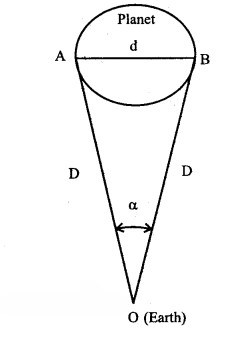
Let A and B are two points on the planet which are diametrically opposite.
Concerning a point O on the earth, using a telescope AÔB = α is measured.
We know,
Length of the arc = (radius) (angle subtended at the centre)
d = αD.
Then the size of the planet can be estimated.
Question 20.
Express (a) 1° (degree) (b) 1′ (1 arc min) (c) 1″ (1 arc second)
Answer:
(a) 1° = 1.745 × 10-2 rad
(b) l’ = 2.91 × 10-4 rad
(c) l’ = 4.847 × 10-4 rad.
Question 21.
Explain the method of estimating the size of oleic acid.
Answer:
1 cm³ of oleic acid is dissolved in alcohol to make a solution of 20 cm³.
1 cm³ of this solution is diluted in alcohol further to a solution of 20 cm³.
Therefore the concentration of the solution
of oleic acid/cm3 of solution.
Little Lycopodium powder is sprinkled on the surface of water taken in a large trough. A few drops of the solution are put on the surface of the water. If n is the number of drops of volume V each, then
Volume of ‘n’ drops of solution = nV
The volume of oleic acid in the solution
The solution spreads fast on the surface of water and forms a thin layer of thickness t. Soon alcohol evaporates and the oleic acid is left on the surface. If A is the area of the thin film,
The volume of the film = (area of the film) (thickness)
= A × t ……(2)
(1) = (2)
The thickness of the film is nothing but the size of the molecules of oleic acid.
Range of Lengths Units and Measurements
Question 1.
What is the order of size of the nucleus?
Answer:
Nuclear size is of the order of 10-14 m.
Question 2.
What is the order of size of the observable universe?
Answer:
The size of the observable universe is of the order of 1026 m.
Question 3.
Mention a few units to measure very short distances
Answer:
A few units to measure very short distances are
(i) Fermi = fm – 10-15m
(ii) Angstrom = A = 10-10 m
Question 4.
Mention a few units to measure very large lengths.
Answer:
few units to measure very large lengths are
(i) Astronomical unit = AU= 1.496 × 1011nm
(ii) Light year = ly = 9.46 × 1015m
(iii) Parsec = 3.08 × 1016m
Question 5.
Define 1 light year.
Answer:
It is the distance travelled by the light in 1 year with a speed of 3 × 108ms-1.
Question 6.
Define 1 astronomical unit.
Answer:
It is the average distance of the sun from the earth.
Question 7.
Mention the largest unit of distance.
Answer:
parsec
Question 8.
Define parsec.
Answer:
It is the distance at which the average radius of the earth’s orbit subtends an angle of 1 arc second.
Question 9.
Express 1 parsec in meter.
Answer:
1 par sec = 3.08 ×1016 s
Question 10.
Mention the unit to express the mass of atoms.
Answer:
Unified atomic mass unit (u).
Question 11.
Express a unified atomic unit in terms of a kilogram.
Answer:
1 unified atomic mass unit
= 1.66 × 10-27 kg
i.e. 1 u = 1.66 × 10-27 kg
Question 12.
Mention the method to measure the mass of planets and stars.
Answer:
gravitational method.
Question 14.
What is the ratio of the largest and smallest measurable mass in our universe?
Answer:
Question 15.
Name the device used to measure the masses of atomic and subatomic particles.
Answer:
mass spectrometer.
Question 16.
What is the principle of a mass spectrograph in measuring the mass of a charged particle?
Answer:
The radius of the trajectory is proportional to the mass of the charged particle moving in a uniform electric and magnetic field.
Question 17.
Mention the range of masses of objects that we come across in the universe.
Answer:
The mass of the objects varies from the mass of the electron, i.e. about 10-30 kg to the mass of the universe, i.e., about 1055kg.
Question 18.
Name the device used to measure the time accurately.
Answer:
The device used to measure time accurately is the caesium atomic clock.
Question 19.
What is the principle behind the caesium atomic clock?
Answer:
The caesium atomic clock is based on the periodic vibrations produced in the caesium atom.
Question 20.
What is the ratio of the longest and shortest lengths of objects in our universe?
Answer:

Question 21.
What is the ratio of the longest and shortest time intervals associated with the events in our universe?
Answer:
Accuracy, Precision of Instrument and Errors, Measurement: Units and Measurements
Question 1.
Write SI unit of Luminous Intensity.
Answer:
Candela
Question 2.
Give an example of a constant which has no unit.
Answer:
Reynold number
Question 3.
What is the error?
Answer:
The uncertainty in measuring a physical quantity using an instrument is called error.
Question 4.
What is meant by accuracy?
Answer:
The accuracy is the measure of how close the measured value is to the true value of the quantity.
Question 5.
What is meant by precision?
Answer:
Precision means to what resolution or limit of the instrument, the quantity is measured.
Question 6.
The true value of a certain length is 3.678 cm. When this length is measured using an instrument of least count 0.1 cm is found to be 3.5 cm. Where the same length is measured using another instrument of least count 0.01 cm is 3.38 cm. Which of the two measurements is
(a) more accurate
(b) more precise?
Answer:
(a) The first measurement (3.5 cm) is more accurate because it is closer to the true value (3.678 cm)
(b) The second measurement is more precise because it is measured to greater resolution.
Question 7.
Mention the two types of error in measurement.
Answer:
The errors are broadly classified as
• Systematic error
• Random error.
Question 8.
What is systematic error?
Answer:
The systematic errors are those that tend to be in one direction, either positive or negative. Systematic error can be eliminated by applying proper correction.
Question 9.
Explain the sources of systematic error with suitable examples
Answer:
The sources of systematic errors are
1. Instrumental error
2. Imperfection in experimental technique
3. Personal error.
1. Instrumental error: This type of error is due to imperfect design or calibration of the measuring instrument and zero error in the instrument. Example:
(i) Due to wrong calibration, the thermometer may read the boiling point of water at STP as 104°C instead of 100°C
(ii) Zero error in the vernier callipers.
2. Imperfection in experimental technique: When the thermometer is placed under the armpit to measure the temperature of the human body, the thermometer reads a temperature lesser than the actual value.
3. Personal errors: This type of error is due to individual bias, lack of proper setting of apparatus, or individual carelessness in taking observations without observing proper precautions. Example-, error due to parallax.
Question 10.
What is the least count?
Answer:
The smallest value that can be measured by a measuring instrument is called the least count.
Question 11.
Explain how the systematic error can be minimized.
Answer:
Systematic error can be minimized by improving experimental techniques, selecting better instruments, and removing personal bias as far as possible.
Question 12.
What is the least count error?
Answer:
The least count error is the error associated with the resolution of the instrument.
Question 13.
Suggest ways to reduce the least count error.
Answer:
The least count error can be reduced by using instruments of higher precision, improving experimental techniques, etc.
Question 14.
How do you determine the true value of a physical quantity when several trials are taken?
Answer:
The arithmetic mean of many trials gives the true value of these quantities.
Question 15.
What is absolute error?
Answer:
The magnitude of the difference between the individual measurement and the true value of the quantity is called absolute error.
Question 16.
What is relative error?
Answer:
The relative error is the ratio of the mean absolute error (∆amean) to the mean value (a mean) of the quantity measured.
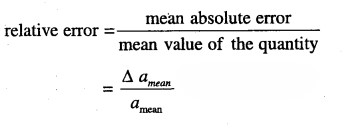
Question 17.
What is a percentage error?
Answer:
The relative error expressed in percent is called percentage error.
percentage error = relative error × 100
Question 18.
Arrive at an expression for absolute error, relative error and percentage error.
Answer:
Let a1 a2, a3 an be several measurements of a physical quantity.
Then arithmetic mean
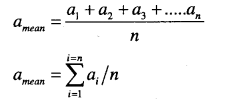
a mean also represents the true value of the quantity.
The magnitude of the difference between the individual measurement and the true value of the quantity is called absolute error.
∆a1 = a1-amean
∆a2 = a2-amean
∆an = an-amean
The arithmetic mean of all the absolute errors represents the mean absolute error.

Relative error is the ratio of absolute error to mean absolute error
Relative error in per cent is called percentage error
percentage error
Question 19.
Discuss the mechanism to calculate the maximum error when two physical quantities A and B are
(i) added (ii) subtracted.
Answer:
If ∆A and ∆B are the absolute error of the physical quantities A and B then
The measured value of A is A ± ∆A
The measured value of B is B ± ∆B.
Where ∆A and ∆B are the absolute error of ∆Z is an error, then Z = A + B.
then Z ± ∆Z = (A ± ∆A) + (B ± ∆B)
(Z ± ∆Z) = (A + B) + (∆A ± ∆B)
Maximum possible error
∆Z = ∆A ± ∆B
(b) for the difference
Z = A – B
(Z ± ∆Z) = (A ± ∆A) – (B ± ∆B)
(Z ± ∆Z) = (A – B) + (∆A ± ∆B)
∴ ∆Z = ∆A ± ∆B
Thus when two quantities are added or subtracted, the absolute error in the final result is the sum of the absolute error in the individual quantities.
Question 20.
Explain the method to calculate maximum error when two quantities are multiplied.
Answer:
If Z is the product of two quantities, then Z = AB ………(1)
If ∆A, ∆B and ∆Z are the absolute error in A, B and Z respectively, then
(Z ± ∆Z) = (A ± ∆A) (B ± ∆B)
= AB + B∆A ± A∆B ± ∆A∆B ….(2)
dividing (2) and (1).

Thus when two quantities are multiplied, the relative error is the sum of the relative error of multipliers.
Question 21.
Show that the relative error in a physical quantity raised to the power k is k times the relative error in the individual quantity.
Answer:
Let Z = A2
A = A.Az
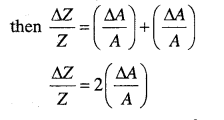
Hence relative error in A² is two times the error in A.
Question 22.
What are significant figures?
Answer:
The reliable digits plus the first uncertain digit are known as significant figures.
Question 23.
Does the number of significant figures depend on the system of units used?
Answer:
No, the number of significant figures does not depend on the system of units used.
Question 24.
State the rule to find absolute error when two quantities are added or subtracted
Answer:
When two quantities are added or subtracted, the absolute error is the sum of the absolute error in the individual quantities, i.e. ∆Z = ∆A + ∆Z
Question 25.
State the rule to find the relative error when two quantities are multiplied or divided.
Answer:
When two quantities are multiplied or divided, the relative error in the result is the sum of the relative error in the multipliers
Question 26.
State the rules to be followed about significant figures.
Answer:
• All non-zero digits in a number are significant
• All the zeros between two non-zero digits are significant irrespective of the position of the decimal point.
• If the number is less than 1, the zero on the right of the decimal point but to the left of the first non-zero digit is not significant.
• The zeros at the end without a decimal point are not significant.
• The trailing zeros in a number with a decimal point are significant. The reliable digits plus the first uncertain digit are known as significant figures.
Question 27.
Explain the scientific notation method of finding the number of significant figures.
Answer:
Every number is expressed as a × 10b, where ‘a’ is a number between 1 and 10 and ‘b’ is the power of 10. The number of digits in the decimal number gives significant figures.
Question 28.
State the rules for rounding off numbers to the appropriate significant figures.
Answer:
The preceding digit is raised by 1 if the insignificant digit to be dropped is more than 5 and is left unchanged if it is less than 5.
If the preceding digit is even, the insignificant digit is simply dropped and if it is odd, the preceding digit is raised by 1.
Question 29.
What are the dimensions of a physical quantity?
Answer:
The dimensions of a physical quantity are the powers to which the base quantities are raised to represent that quantity.
Question 30.
What is the dimensional formula?
Answer:
The expression which shows how and which of the base quantities represent the dimensions of a physical quantity is called the dimensional formula.
Question 31.
What is the dimensional equation?
Answer:
The relation between the given physical quantity and the fundamental quantities expressed in the form of an equation is called a dimensional equation. ‘
Question 32.
Name two pairs of physical quantities that have the same dimensions.
Answer:
Impulse and momentum have the same dimensions [M¹L T-¹].
Question 33.
Name a physical quantity that has a unit but no dimensions.
Answer:
Angle in a plane. It has a unit radian but no dimensions
Question 34.
Name a few physical quantities that have neither units nor dimensions.
Answer:
refractive index, specific gravity, Reynold’s number, magnetic susceptibility, etc. have neither units nor dimensions.
Question 35.
Given a few uses of dimensional equations.
Answer:
Dimensions of physical quantities are used to check the corrections of an equation.
Convert the unit of a given derived physical quantity from one system of units to another.
derive the relation connecting the given physical quantities.
Question 36.
State the principle of homogeneity of dimensions.
Answer:
According to this principle, the dimensions of all the terms in a given physical equation must be the same. It signifies that only similar physical quantities can be added, subtracted, or equated.
Question 37.
Using the principle of homogeneity, check the correctness of the equation v2 = v02 + 2ax
Answer:
dimensions of v² = [LT ‾¹] = [L²T-²]
dimensions of v02 =[LT ¯¹]² = [L²T-²]
dimensions of 2ax = [LT¯²][L] = [L²T¯²]
Note: 2 is a number, it has no unit.
Since the dimensions of each form in the given equation are the same, the equation is dimensionally correct.
Question 38.
Check the dimensions of the equations
(i) x = x0 + v0t +½ at2
(ii) ½ mv2 =mgh
Answer:
(i) dimensions of x = [L]
dimensions of x0 = [L]
dimensions of v0t = [LT ‾ ¹] [T] = [L]
dimensions of 1/2 at² = [LT ‾²][T²] = [L]
since the dimensions of each term of the given equation are the same the given equation is dimensionally correct.
ii) Dimension of 12 mv2
= [M][LT-1]2
[M1L2T-2]
Dimensions of mgh = [M] [LT-2][L]
= [M1L2T-2]
Note: 1/2 is a fraction; it has no dimension.
Since dimensions of LHS = dimensions of RHS, the given equation is dimensionally correct.
Question 39.
Check the dimensions of the equation 12 mv minus 12 mu =22 FS
Answer:
Dimensions of 12 mv =2 [M][LT-1]2 =[ML2T-2]
Dimensions of 12 mu2 = [M][LT-1]2 = [ML2T-2]
Dimensions of FS = [MLT-2][L] = [ML2T-2]
Since the dimensions of each term in the equation are the same, the given equation is dimensionally correct.
Question 40.
If the time period of oscillation of the simple pendulum depends on length (l), mass of the bob and acceleration due to gravity, derive the expression for its time period using the method of dimensions.
Answer:
Since time period (T) depends on length (l), mass (m) and acceleration due to gravity (g).
T ∝ lxmygz
T = k lxmygz ….. (1)
Where K is a dimensionless constant and x, y and z are components to be determined.
[T] = [L]x[M]y[LT-2]z
Since dimensions of similar quantities is the same on both sides. Equating the powers of L
0 = x + z ⇒ x = -z
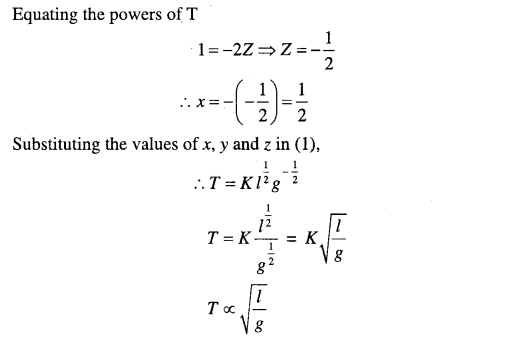
Question 41.
If the frequency of a stretched string depends on length (1), tension (T) and linear density (μ), derive the expression for frequency using the method of dimensions.
Answer:
Given, that frequency (v) depends on length (l), tension (T) and linear density (μ).
∴ v ∝ lxTyμz
v = k lxTyμz ….. (1)
Where K is a dimensionless constant
Dimensions of v = [T-1]
Dimensions of l=[L]
Dimensions of T = [MLT2]
Dimensions of μ = [ML-1]
∴ [T-1] = [L]x[MLT-2]y[ML-1]z
Since the dimensions of similar physical quantities are the same on both sides, equating the powers of M,
0 = y + z ⇒ y = -z
Equating the power of L
O = x + y – z
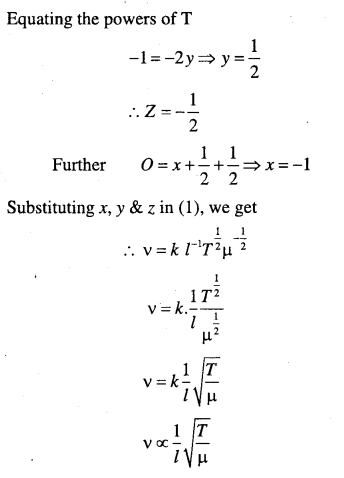
Question 42.
If centripetal force acting on a body depends on its mass (m), velocity (y) and radius of the circular path
(r), derive an expression for centripetal force.
Answer:
Given centripetal for (F) depends on mass (m), velocity (y) and radius (r)
F ∝ mxvyrz
F = Kmxvyrz
Dimensions of F = [MLT-2]
Dimensions of m = [M]
Dimensions of y = [LT-1]
Dimensions of r = [L]
[MLT-2] = [M]x [LT-1]y [L]z
Equating the powers of M
1 = x
Equating the powers of L
1 = y + z
Equating the powers of T
-2 = -y ⇒ y = 2
∴ 1 = 2 + Z ⇒ Z = -1
Substituting x, y, z in (1),
∴ F=K.m1v2r-1
Question 43.
Convert the force of 1 Newton into dyne.
Answer:
Newton and Dyne are the units of force. The dimensions of force are [MLT ‾²]
Let 1 newton = n dyne
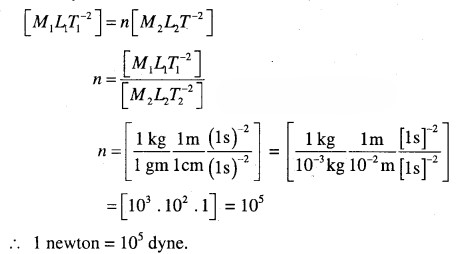
Question 44.
Convert joule to erg.
Answer:
Joule and erg are the units of energy. The dimensions of energy is [ML²T ‾²]
Let 1 joule = n(erg)
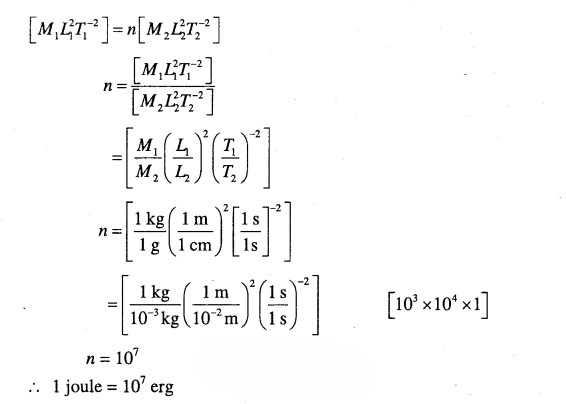
Question 45.
Mention the limitations of dimensional analysis.
Answer:
• The value of the constant of proportionality cannot be determined.
• Relation for a physical quantity cannot be obtained if it depends on more than the fundamental quantities i.e. length, mass and time.
• This method cannot be used for trigonometric, logarithmic or exponential functions
• The relation between physical quantities can be deduced if the relation is of the form product.
Question 46.
State the number of significant figures in the following:
(a) 0.007 m²
(b) 2.64 × 1024 Mkg
(c) 0.2370 g cm¯³
(d) 6.320 T
(e) 6.032 Nm²
(f) 0.0006032 m²
Answer:
(a) 0.007 m² = 7 × 10‾¹³ m. The number of significant figures is 1
(b) 2.64 × 1024kg, the number of significant figures is 3
(c) 0.2370 cm‾³= 2.370 × 10‾¹. ∴ number of significant is 4
(d) 6.320 ∴ number of significant figure is 4
(e) 6.032 number of significant figures is 4
(f) 0.0006032 = 6.032 × 10-4
.’. a number of significant figures is 4.
Question 47.
Reduce the following values to 3 significant figures
(i) 3.424
(ii) 9.335
(iii) 6.725
(iv) 4.638
Answer:
Correct to 3 significant figures
(i) 3.424 = 3.42
(ii) 9.335 = 9.34
(iii) 6.725 = 6.72
(iv) 4.638 = 4.64.
Question 48.
Calculate the angle of (a) 1° (degree), (b) V (minute of arc or are min), and (c) 1″ (second of arc or arc second) in radians. Use 360° = 2π rad. 1° = 60′ and 1′ = 60″.
Answer:
(a) 360° = 2π rad
1° = (π/180) rad = 1.745 × 10‾² rad
(b) 1° = 60′ = l-745 ×10-2 rad
1′ = 2.908 × 10-4 rad ≅ 2.91 × 10-4 rad
(c) 1′ = 60″ = 2.908 × 10-4 rad
1” = 4.847 × 10-4 rad = 4.85 × 10-6 rad
Question 49.
The moon is observed from two diametrically opposite points A and B on Earth. The angle θ subtended at the moon by the two directions of observation is 1°54′. Given the diameter of the Earth to be about 1.276 x 107 m, compute the distance of the moon from the Earth.
Answer:
θ = 1°54′ = 114′
= (114 × 60)” × (4.85 × 10-8) rad
= 3.32 × 10-2 rad,
Since 1” = 4.85 × 10-8 rad , also b = AB = 1.276 × 107m
We have the earth-moon distance, D = b/∅
= 3.84 × 108m
Question 50.
The sun’s angular diameter is measured to be 1920″. The distance D of the sun from the Earth is 1.496 x 1011 m. What is the diameter of the sun?
Answer:
Sun’s angular diameter α = 1920″
= 1920 × 4.85 × 10-6 rad = 9.31 × 10-3 rad
Sun’s diameter = d = αD
= (9.31 × 10-3) × (1.496 × 1011)m = 1.39 × 109m
Question 51.
The temperatures of two bodies measured by a thermometer are
t1 = 20°C ± 0.5°C and t2 = 50°C = 0.5°C Calculate the temperature difference and the error therein.
Answer:
t’ = t2 – t1 = (50°C ± 0.5°C) – (20°C + 0.5°C)
t’ = 30°C ± 1°C
Question 52.
The resistance R = VII, where V = (100 ± 5)V and I = (10 ± 0.2) A. Find the percentage error in R.
Answer:
The percentage error in V is 5% and in I it is 2%.
The total error in R would therefore be 5% + 2% = 7%.
Question 53.
Each side of a cube is measured to be 7.203 m. What are the total surface area and the volume of the cube to appropriate significance figures?
Answer:
The number of significant figures in the measured length is 4. The calculated area and the volume should therefore be rounded off to 4 significant figures.
Surface area of the cube = 6(7.203)²m²
= 311.299254 m² = 311.3 m²
Volume of the cube = (7.203)³m³
= 373.714754 m³ =373.7 m³
Question 54.
Let us consider an equation 1/2 mv² = mgh, where m is the mass of the body, v is its velocity, g is the acceleration due to gravity, and h is the height. Check whether this equation is dimensionally correct.
Answer:
The dimensions of LHS are
[M][LT-1]2 =[M][L2T-2]
= [ML2T-2]
The dimensions of RHS are
[M][LT-2][L] = [M][L2T-2]
=[ML2T-2]
The dimensions of LHS and RHS are the same and hence the equation is dimensionally correct.
Question 55.
5.74 g of a substance occupies 1.2 m³. Express its density by keeping the significant figures in view.
Answer:
There are 3 significant figures in the measured mass,, as there are only 2 significant figures in the measured volume. Hence the density should be expressed in only 2 significant figures.
Question 56.
Fill in the blanks
(a) The volume of a cube of side 1 cm is equal to ……… m³
(b) The surface area of a solid cylinder of radius 2.0 cm and height 10.0 cm is equal to …(mm)²
(c) A vehicle moving with a speed of 18 km h_1 covers minis
(d) The relative density of lead is 11.3. Its density is …g cm¯³ or ….kg m¯³.
Answer:
(a) Volume of a cube = (side)3
= (1 cm)3 = (1 × 10-2m)3 = 1 × 10-6 m3
(b) The surface area of a solid cylinder is given by S – 2πr(h + r)
Where r – radius = 2 cm = 20 mm and h = height = 10 cm = 100 mm.
∴ Surface area = 2 × π × 20(100 + 20)
= 4800 × 3.14 = 1.5 × 104mm2
Note: km h-1 can be converted to ms-1 by multiplying by 5/18.
(d) Actual density = relative density × density of water.
Density in g cm-3= 11.3 × 1 g cm-3
Density in kg m-3= 11.3 × 1000 kgm3 = 11300 kgm-3
Question 57.
Fill in the blanks by suitable conversion of units,
(a) 1 kg m2 s-2 = ….g cm2s-2
(b) 1 m = ly
(c) 3.0 m s-2 =…. km h-2
(d) G = 6.67 × 10-11cm2(kg) = ……. (cm)3 s2 g-1 .
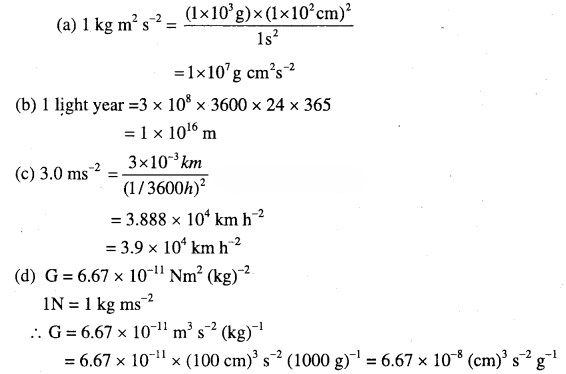
Question 58.
A calorie is a unit of heat or energy and it equals about 4.2 J where 1J = 1 kg m2 s-2. Suppose we employ a system of units in which the unit of mass equals a kg, the unit of length equals p m, the unit of time is λS. Show that a calorie has a magnitude of 4.2 o^pV in terms of the new units.
Answer:
new unit of mass = α kg
1 kg =1⁄α new units of mass
1 new unit of length = βm
1 m = 1⁄β new units of length
1 new unit of time = γ s
1s = 1⁄γ new unit of time
1 calorie = 4.2 kg m2 s-2
= 4.2α-1β2γ2 in terms of the new units.
Question 59.
A new unit of length is chosen such that the speed of light in vacuum is unity. What is the distance between the Sun and the Earth in terms of the new unit if light takes 8 min and 20 s to cover this distance?
Answer:
New unit of length = 3 × 108 ms-1
Distance between the Earth and the sun = (8 mm 20 s) × 3 × 108 ms-1
= 500 × 3 × 108 ms-1
∴ Distance between the Earth and the Sun in terms of the new units
Question 60.
Which of the following is the most precise device for measuring length:
(a) a vernier calipers with 20 divisions on the sliding scale
(b) a screw gauge of pitch 1 mm and 100 divisions on the circular scale
(c) an optical instrument that can measure length to within a wave – length of light?
Answer:
(a) Least measurement possible with vernier callipers = 1⁄10 mm = 5 × 105 m
(b) Least measurement possible with screw gauge =1⁄100 mm = 1 × 10-5m
(c) Least measurement possible with the optical instrument = 300 nm = 3 × 10-7 m Clearly, (c) is the most precise device.
Question 61.
A student measures the thickness of a human hair by looking at it through a microscope of
magnification 100. He makes 20 observations and finds that the average width of the hair in the field of
view of the microscope is 3.5 mm. What is the estimate on the thickness of hair?
Answer:

Question 62.
Answer the following:
(a) You are given a thread and a meter scale. How will you estimate the diameter of the thread?
(b) A screw gauge has a pitch of 1.0 mm and 200 divisions on the circular scale. Do you think it is possible to increase the accuracy of the screw gauge arbitrarily by increasing the number of divisions on the circular scale?
(c) The mean diameter of a thin brass rod is to be measured by vernier callipers. Why is a set of 100 measurements of the diameter expected to yield a more reliable estimate than a set of 5 measurements only?
Answer:
(a) Repeatedly wind the thread over the breadth of the scale such that there is no space between adjacent windings. Find the number of windings in a given length.
Diameter of the thread
(b) No. When the number of divisions is arbitrarily increased, the accuracy might increase up to a certain extent only.
(c) When more measurements are taken, the likelihood of random errors is decreased. Hence a set of 100 measurements is more reliable than a set of 5 measurements.
Question 63.
The photograph of a house occupies an area of 1.75 cm² on a 35-nine slide. The slide is projected onto a screen, and the area of the house on the screen is 1.55 m². What is the linear magnification of the projector-screen arrangement?
Answer:
Area of the house = 1.75 cm2
Let’s assume that the house is square in shape.
Length of a side of the house = √1.75 cm
Area of the house on the screen 1.55 m2
Length of a side of the house on the screen = √1.55 m = √1.55 × 100 cm

Question 64.
The length, breadth and thickness of a rectangular sheet of metal are 4.234 m, 1.005 m, and 2.01 cm respectively. Give the area and volume of the sheet to correct significant figures.
Answer:
Length l = 4.234 m, Breadth b = 1.005 m, Thickness t = 2.01 cm = 0.0201 m,
Area = 2 × (lb + bt +lIt)
= 2 × (4.234 × 1.005 + 1.005 × 0.0201 + 4.234 × 0.0201) = 8.72 m²
(Rounding off to 3 significant figures)
Volume = l × b × t
= 4.234 × 1.005 × 0.0201 = 8.55 × 10‾² m³
Question 65.
The unit of length convenient on the atomic scale is known as an angstrom and is denoted by Å: 1 Å = 10-10 m. The size of a hydrogen atom is about 0.5 Å. What is the total atomic volume in m3 of a mole of hydrogen atoms?
Answer:
The radius of a hydrogen atom = r = 0.5 Å = 0.5 x 10-10m.
Volume of a mole of hydrogen atoms = Volume of a hydrogen atom × Number of hydrogen atoms in 1 mole
= 4⁄3 πr3 × NA
= 4⁄3 × 3.14 × (0.5 x 10-10)3 × 6.022 × 1023
= 3 × 10-7m3 (rounded off to 1 significant figure)
Question 66.
It is claimed that two caesium clocks, if allowed to run for 100 years, free from any disturbance, may
differ by only about 0.02 s. What does this imply for the accuracy of the standard caesium clock in measuring a time interval of 1 s?
Answer:
Since the maximum error possible for 2 clocks is 0.02 s, the error for 1 clock is 0.01 s.
∴ Accuracy
= 3.15 × 1011
= 1 part in 1011 to 1012
1st PUC Physics Units and Measurements Notes
